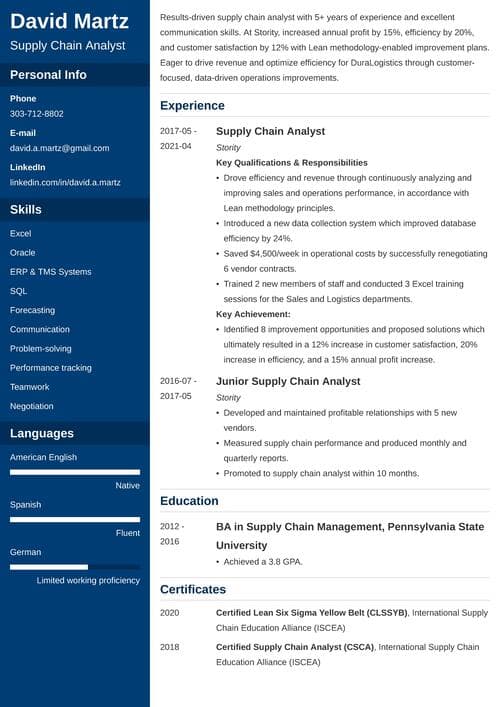
Supply Chain Analyst Resume: Sample & Writing Guide
Ever feel like your job applications are getting lost in transit? Eliminate inefficiencies in your job hunting with a perfect supply chain analyst resume.
No matter how many job applications you send, your efficiency rate is still stuck at 0%. It’s starting to seem like the only thing getting a boost is your burn rate, and landing an interview is harder than shifting dead stock.
Well, you’re not alone—
Getting a great supply chain analyst job can be a tall order. It’s a surprisingly competitive industry, with dozens of candidates for each decent opportunity. To make matters even worse, many of them are bound to have much more experience than you (or better connections).
The solution?
Supply a resume that meets every demand.
This guide will show you:
- A supply chain analyst resume example better than 9 out of 10 other resumes.
- How to write a supply chain analyst resume that will land you more interviews.
- Tips and examples of how to put skills and achievements on a supply chain analyst resume.
- How to describe your experience on a resume for a supply chain analyst to get any job you want.
Want to save time and have your resume ready in 5 minutes? Try our resume builder. It’s fast and easy to use. Plus, you’ll get ready-made content to add with one click. See 20+ resume templates and create your resume here.
Sample resume made with our builder—See more resume examples here.
Considering applying for other jobs, too? Check out these guides:
- Supply Chain Resume Sample
- Supply Chain Manager Resume Sample
- Business Analyst Resume Sample
- System Analyst Resume Sample
- Warehouse Resume Sample
- Warehouse Supervisor Resume Sample
- Warehouse Manager Resume Sample
- Operations Manager Resume Sample
- Amazon Resume Sample
- Retail Resume Sample
- Retail Sales Associate Resume Sample
- Best Resume Samples for Any Profession
Supply Chain Analyst Resume Sample
David Martz
Supply Chain Analyst
303-712-8802
linkedin.com/in/david.a.martz
Summary
Results-driven supply chain analyst with 5+ years of experience and excellent communication skills. At Stority, increased annual profit by 15%, efficiency by 20%, and customer satisfaction by 12% with Lean methodology-enabled improvement plans. Eager to drive revenue and optimize efficiency for DuraLogistics through customer-focused, data-driven operations improvements.
Experience
Supply Chain Analyst
Stority
May 2017–April 2021
Key Qualifications & Responsibilities
- Drove efficiency and revenue through continuously analyzing and improving sales and operations performance, in accordance with Lean methodology principles.
- Introduced a new data collection system which improved database efficiency by 24%.
- Saved $4,500/week in operational costs by successfully renegotiating 6 vendor contracts.
- Trained 2 new members of staff and conducted 3 Excel training sessions for the Sales and Logistics departments.
Key Achievement:
- Identified 8 improvement opportunities and proposed solutions which ultimately resulted in a 12% increase in customer satisfaction, 20% increase in efficiency, and a 15% annual profit increase.
Junior Supply Chain Analyst
Stority
July 2016–May 2017
- Developed and maintained profitable relationships with 5 new vendors.
- Measured supply chain performance and produced monthly and quarterly reports.
- Promoted to supply chain analyst within 10 months.
Education
BA in Supply Chain Management, Pennsylvania State University
2012–2016
- Achieved a 3.8 GPA.
Skills
- Excel
- Oracle
- ERP & TMS Systems
- SQL
- Forecasting
- Communication
- Problem-solving
- Performance tracking
- Teamwork
- Negotiation
Certifications
Certified Lean Six Sigma Yellow Belt (CLSSYB)
International Supply Chain Education Alliance (ISCEA), 2020
Certified Supply Chain Analyst (CSCA)
International Supply Chain Education Alliance (ISCEA), 2018
Languages
- American English: Native
- Spanish: Fluent
- German: Limited working proficiency
Here’s how to write a job-winning supply chain analyst resume:
1. Choose the Right Format for Your Supply Chain Analyst Resume
You can’t hope to land a good supply chain analyst job with a resume that looks like an invoice that just came out of a 1980s fax machine. So, the first performance inefficiency we need to tackle is the formatting of your soon-to-be winning resume.
In terms of how to organize and present your data, it’s best to stick to the reverse-chronological format for supply chain analyst resumes. This means that you’ll be listing your most recent experience first to highlight your biggest accomplishments as a supply chain professional.
Here’s a condensed bill of activities for formatting your resume:
- Pick a modern resume template with a clean, appealing design. It will immediately stand out among the dozens of basic Word resumes on the recruiter’s desk.
- Set standard resume margins (1 inch on all sides). The text should be left-aligned, with 1–1.15 line spacing and plenty of white space.
- Choose a good resume font like Calibri or Georgia and set it to 11–12 points for optimum readability.
- Divide your document into clear resume sections, using 13–14-point headings.
- Stick to the best resume length: one page if you have fewer than 7 years of experience, up to two pages if you’re a seasoned supply chain pro.
Looking good! We still need a bill of materials, so—
Here’s what to include on your supply chain analyst resume:
- Resume header: your name, job title, and contact information.
- Resume profile: your biggest professional accomplishments, summed up in 2–4 sentences.
- Work experience: a list of relevant previous jobs, with bullet points highlighting your proudest moments.
- Education: details of the highest level of schooling you’ve completed, e.g. your BA or MBA.
- Skills: a list of your best supply chain analysis skills, tailored to the job ad.
- Other sections: certificates, awards, memberships, languages, and anything else worth sharing.
When you’re done, export your resume as a PDF file. The PDF format will keep your layout intact, plus it works well for ATS software used by most companies. Keep a Word Doc copy just in case the employer asks for a .docx file.
Still working on setting the right framework for your data? Check here: The Complete Guide to Resume Structure
To maximize the efficiency of your resume writing process, create your resume profile last. Starting with your profile would be like trying to pull insights from a data report that doesn’t exist yet!
2. Start with Your Work Experience Section
Your work experience resume section is the most time-intensive part of the process. It forms the bulk of the order and will receive the most attention from the recruiter, so it’s crucial to get it right.
How?
Well—
By focusing on the outcomes of your actions rather than on your assigned duties.
List your relevant work experience, starting with the most recent (or current) position.
For each entry, add:
- The name of the company, your job title, and the dates you worked there. Include the month and year, e.g. February 2010–May 2015.
- (Optional) 1–2 sentences outlining the scope of your position or the company profile.
- Up to 6 bullet points briefly describing your biggest achievements on the job.
- (Optional) A separate Key Achievement to highlight a particularly impressive moment of your career.
As you can see, it’s a pretty simple system for presenting your data. The most challenging part of the process is outlining your achievements—luckily, there’s a framework for those, too!
Here’s how to write your bullet points:
- Focus on your own experience, not on the general duties of a supply chain analyst. The recruiter already knows what the job involves—they want to know how well you can do it.
- Start each bullet point with an action verb. It shows you’re proactive and willing to take responsibility for your actions (rather than blaming Steve in procurement, or the logistics guy, or the sales team…).
- Add numbers to quantify your achievements whenever possible. Reduced lead times by 23% sounds much better than helped to improve efficiency.
- Choose achievements most relevant to the job you’re applying for. A tailored resume has a much higher chance of on-time delivery.
- Use the PAR (Problem-Action-Result) formula for clarity.
Let’s run a simulation to see how our network performs:
Supply Chain Business Analyst Resume Examples [Work Experience]
| RIGHT |
|---|
Supply Chain Analyst Stority May 2017–April 2021 Key Qualifications & Responsibilities
Key Achievement:
|
Woah!
That’s an Amazon-ready candidate about to land an interview! See how the numbers stand out?
For comparison, here’s a bad resume example from the same candidate:
| WRONG |
|---|
Stority, Supply chain analyst 2017–2021
|
Hmm—
Makes you wonder what those “reports for management” looked like, doesn’t it?
In the first example, the candidate comes across as enthusiastic (but not too enthusiastic), efficient, and most importantly, good at their job. In the second one, there’s a major shortage of all three.
These examples show that the packaging is just as important as the contents of the shipment. It’s not enough to have 4 years of supply chain analytics experience to land a job—you need to know how to present it in your resume.
Okay—
But what if you’re writing an entry-level supply chain analyst resume?
The same delivery methods apply:
Supply Chain Analyst Resume: Entry Level Examples [Work Experience]
| RIGHT |
|---|
Supply Chain Analysis Intern LogiCo June 2020–September 2020 Key Qualifications & Responsibilities
Key Achievement:
|
Isn’t that an impressively consistent flow of goods?
You don’t need a Fortune 100 4PL-level of experience to write a successful entry-level resume. All it takes is the right presentation of your skills.
| WRONG |
|---|
LogiCo, Supply Chain Internship Summer 2020
|
Not terrible—
But far from the maximum capacity. Being an intern doesn’t mean you can’t take initiative, meet your goals, and participate in noteworthy, measurable outcomes.
No experience whatsoever? You can still write a kick-ass resume. Read more: How to Write a Resume with No Work Experience
When making a resume in our builder, drag & drop bullet points, skills, and auto-fill the boring stuff. Spell check? Check. Start building a professional resume template here for free.
When you’re done, Zety’s resume builder will score your resume and tell you exactly how to make it better.
3. Make Your Education Section Count
For most supply chain analyst jobs, you’ll need at least an Associate degree in a relevant field. Even if your college years are long gone, your hard-earned degree deserves a separate section on your resume.
If you’re an experienced supply chain professional, it’s enough to simply write down your degree, college name, and years of attendance, like so:
Supply Chain Analyst Resume Examples [Education]
| RIGHT |
|---|
BA in Supply Chain Management, Pennsylvania State University 2012–2016
|
Easy!
This candidate wanted to show off their GPA on a resume. It’s a good idea, but only if it’s above 3.5. Listing a 2.5 GPA would be like accidentally deleting your annual lead times spreadsheet five minutes before you’re due to present your key performance insights.
Now, if you don’t have many achievements to list in your work history, borrow some stock from your education to fulfill the order on your resume.
Add bullet points to your degree, outlining your relevant coursework, impressive extracurriculars, academic awards, and any other noteworthy achievements.
Like this:
Entry-level Supply Chain Analyst Resume Sample [Education]
| RIGHT |
|---|
BA in Supply Chain Management, Michigan State University 2015–2019
|
Read more: The Right Way to List Your Education on a Resume
4. List the Right Skills on Your Supply Chain Analyst Resume
Time to take stock of your best professional skills:
Ten of them need to be packed and shipped with your resume ASAP. So—
Here’s how to come up with a job-winning supply chain analyst skills section:
- Make a master list of all the skills you’ve acquired during your education and career. Remember to include both soft and hard skills. (Given your profession, you’re probably already planning a dedicated Excel sheet. Good idea!)
- Review the job ad. What specific skills is the employer looking for? List them in a separate column.
- Do what you do best and identify data patterns. What skills appear on both lists? Which seem to carry the most weight? They’re the ones to put on your resume!
With some basic ABC inventory control, you should end up with around 8–10 relevant supply chain analyst skills.
Just in case you want to cross-reference your bill of landing with a template, here are the most popular supply chain analyst skills to mention on a resume:
Supply Chain Analyst Resume Skills
- Analytical skills
- Mathematical analysis
- SQL
- Inventory management
- Forecasting
- Identifying inefficiencies
- Presentation skills
- Project management
- Strategic planning
- Performance tracking
- Database management
- Data analysis
- Data visualization
- Data interpretation
- Communication skills
- Decision-making
- Problem-solving
- Critical thinking skills
- Active listening
- Active learning
- Adaptability
- Collaboration or Teamwork
- Time management
- Confidence
- Negotiation
Software Skills for a Supply Chain Analyst Resume
- Excel
- MS Office
- Google Suite
- Oracle
- SAP
- APO Systems
- ERP Systems
- TMS Systems
A resume-ready skills list will look something like this:
Supply Chain Analyst Resume Template [Skills]
| RIGHT |
|---|
|
Read more: The Best Skills to Put on a Resume: 99+ Examples
5. Add Other Sections to Your Supply Chain Analyst Resume
Got additional value to add to your resume? Allocate your extra resources into separate sections at the end of the document.
Here’s what you could include to make your resume stand out like a lone DPD parcel on a freighter:
- Awards relevant to your position. Supply Chain Excellence Award, anyone?
- Certifications—your CSCA or Microsoft Excel Professional certification could give you the edge you need to beat the competition.
- Memberships in professional associations like the ASCM, to show your dedication to your profession.
- Volunteering—free gigs like teaching Excel at your local public library or helping a non-profit with their accounts can work as proof of your skills and expertise.
- Languages, including your level of fluency. Even the most basic working proficiency can come in useful in your field.
This is what your additional sections may look like on arrival:
Supply Chain Analyst Resume Example [Other Sections]
| RIGHT |
|---|
Certifications
Certified Lean Six Sigma Yellow Belt (CLSSYB) International Supply Chain Education Alliance (ISCEA), 2020
Certified Supply Chain Analyst (CSCA) International Supply Chain Education Alliance (ISCEA), 2018
Languages
|
Are hobbies on a resume still a thing? Find out: Hobbies and Interests on a Resume: Guide and Examples
6. Write a Supply Chain Analyst Resume Objective or Resume Summary
Nearly done!
Just one more section on backorder: your job-winning resume profile.
This is a short paragraph just below the header of your resume. Its purpose? To pull the most relevant data from your resume and present it in a bite-sized, easy-to-read format.
There are two types of resume profiles: a summary, recommended for experienced candidates, and an objective for entry-level applicants. We’ll see examples of both in a minute—
But first, here’s how to write the perfect resume profile:
- Start with an adjective, like proven, reliable, or detail-oriented.
- Add your job title and years of experience. You’ll end up with something like this: Proven supply chain analyst with 3+ years of experience.
- Write a sentence or two about your biggest professional accomplishment(s). It’s okay to repeat achievements already mentioned in your work experience section.
- Refer to one or two key skills from the job ad.
- End on an offer to the employer, targeted to the company’s needs, goals, or values. This shows that you’ve done your research and gives the recruiter an instant deliverable.
Let’s take a look at an excellent resume summary for an experienced supply chain analyst:
Supply Chain Analyst Resume Summary
| RIGHT |
|---|
Results-driven supply chain analyst with 5+ years of experience and excellent communication skills. At Stority, increased annual profit by 15%, efficiency by 20%, and customer satisfaction by 12% with Lean methodology-enabled improvement plans. Eager to drive revenue and optimize efficiency for DuraLogistics through customer-focused, data-driven operations enhancements. |
Boom!
Who could say no to those numbers? Or that offer at the end? This candidate follows every rule and leaves no room for guesswork, presenting the recruiter with immediate value.
Now for a not-so-excellent example:
| WRONG |
|---|
Experienced professional with great communication and analytical skills. Proven ability to collect data and maximize efficiency through extracting actionable insights. Looking for a permanent position in a fast-paced work environment where I can continue to improve my skills. |
Okay—
Anti-competitive activity at its best. Here, the candidate provides no proof of his “proven” abilities. To make matters worse, the last sentence is all demand and no supply. Plus, it fails to even mention the name of the company (or the job title).
If you’re writing an entry-level supply chain analyst resume, you can focus on your academic achievements and specific skills instead.
This resume objective example delivers the goods on time:
Supply Chain Analyst Resume Objective
| RIGHT |
|---|
Entry-level supply chain analyst with exceptional forecasting and computer skills. Achieved a 3.8 GPA and demonstrated a particular talent for SCM decision modeling and simulations. Eager to join LogiCo and leverage my skills towards maximizing efficiency, optimizing SCM processes, and driving revenue. |
See?
This candidate packed a whole kit of relevant skills into one short paragraph. She also included a specific offer tailored to the employer.
With an intro like this, she could easily outperform most resumes from more experienced candidates!
Whereas this one is still stuck at customs:
| WRONG |
|---|
Recent graduate seeking an entry-level position in supply chain management or analysis. Can collect and analyze data, use Excel and other relevant software, and produce high-quality reports. Good at creating and presenting forecasts. |
Return to sender.
Not only does this person not care about the company, but they also don’t even mind what position they’ll get. Plus, they give no evidence for the skills they claim to have.
Read more: Writing a Perfect Resume Introduction: Guide & Examples
7. Attach a Supply Chain Analyst Cover Letter
A resume without a cover letter is like a shipping label without a barcode: pointless. As our HR research shows, a surprising 45% of recruiters reject applications simply because they don’t include a cover letter!
Luckily, writing a great supply chain analyst cover letter is easier than running an SQL command.
Here’s how to write a job-winning cover letter:
- Use the right cover letter format. For bonus points, make sure the design of your cover letter matches that of your resume.
- Start your cover letter with an impressive achievement and an offer tailored to the company.
- Describe your proudest professional moments, show how your skills can benefit the company, and prove you’re a good fit.
- End your cover letter on an offer to describe your experience in more detail during an interview.
That wasn’t so bad, was it? Just remember to focus on your accomplishments and show you understand the company and the role, and you’ll be getting ready for an interview in no time at all!
Read more: What to Say in Your Cover Letter
Plus, a great cover letter that matches your resume will give you an advantage over other candidates. You can write it in our cover letter builder here. Here's what it may look like:
See more cover letter templates and start writing.
Key Takeaway
Here’s a recap of how to write a supply chain analyst resume:
- Format your resume and organize your data in the reverse-chronological order.
- Start with your work experience section. Focus on providing stats and figures to quantify your accomplishments.
- Add your education, providing more detail if you’re a newly graduated supply chain pro.
- Include a couple of additional sections for extra certifications, awards, and experience.
- List your most relevant professional skills.
- Write your career profile with the company in mind.
- Attach a perfect cover letter that expands on your experience and skills.
That’s it! Now, we’d love to hear from you:
- What’s the most challenging part about writing a supply chain analyst resume?
- Do you feel like you have trouble writing a good work experience section as an entry-level supply chain analyst?
- Is it difficult to quantify your achievements from previous supply chain jobs?
Let’s chat below in the comments, and thanks for reading!




